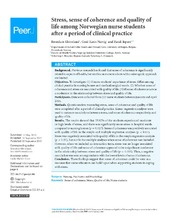Stress, sense of coherence and quality of life among Norwegian nurse students after a period of clinical practice
Peer reviewed, Journal article
Published version

Åpne
Permanent lenke
https://hdl.handle.net/1956/11295Utgivelsesdato
2015-09-29Metadata
Vis full innførselSamlinger
Originalversjon
https://doi.org/10.7717/peerj.1286Sammendrag
Background. Previous research has found that sense of coherence is significantly related to aspects of health, but studies on nurse students with a salutogenic approach are limited. Objectives. To investigate (1) if nurse students’ experience of stress differs among clinical practice in nursing homes and medical/surgical wards. (2) Whether sense of coherence and stress are associated with quality of life. (3) If sense of coherence acts as a moderator in the relationship between stress and quality of life. Participants. Data were collected from 227 nurse students between January and April 2014. Methods. Questionnaires measuring stress, sense of coherence and quality of life were completed after a period of clinical practice. Linear regression analyses were used to measure associations between stress, and sense of coherence respectively, and quality of life. Results. The results showed that 33.92% of the students experienced moderate or high levels of stress, and there was significantly more stress in hospital wards compared to nursing homes (p = 0.027). Sense of coherence was positively associated with quality of life in the simple and multiple regression analyses (p < 0.01). Stress was negatively associated with quality of life in the simple regression analysis (p < 0.01), but not in the multiple analyses when sense of coherence was included. However, when we included an interaction term, stress was no longer associated with quality of life and sense of coherence appeared to be a significant moderator in the relationship between stress and quality of life (p = 0.015). Thus, a negative association was seen among students with the lowest levels of sense of coherence. Conclusion. These findings suggest that sense of coherence could be seen as a resource that nurse educators can build upon when supporting students in coping with stress.
